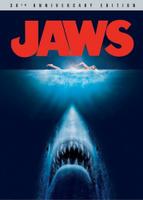
Well, director Peter Jackson has done it again. He has made another 3 hour epic film that will inevitably rake in the Oscars at the Academy Awards. This time, however, the film does not have a three foot man, but a 25 foot ape. I am talking about, of course, Jackson's newest film, King Kong (2005). A remake of the classic 1933 edition, Jackson has stated many times that it was this film that was his main inspiration for becoming a director, so it is fitting that the special effects 'King' should remake the 'King' of all special effects.
Carl Denham (Jack Black) is a movie director, who is failing along with the majority of New York City. After messing up on his last chance, Carl rounds up a cast for his film, and sets out for an island to film on (without permission of his endorsers). The destination: a mythic island thought to be a legend. The scenic (and ominously named) Skull Island has beautiful beaches of jagged rocks, a wonderful wildlife of gigantic carnivorous insects, and even a population of 'extinct' dinosaurs. Its greatest attraction, of course, is the title character; a 25 foot ape who develops love for Carl's leading actress, Ann Darrow (Naomi Watts).
Also included in Carl's crew is the famous playwright Jack Driscoll (Adrien Brody), who is idolized by Ms. Darrow, and is the main reason she joined the cast. This idolization soon changes to love, causing a love triangle to form between Ann, the famous playwright, and a 25 foot tall dirty ape (who would you choose?). When Ann is kidnapped by Kong (Andy Serkis), Jack goes to rescue Ann, and even ventures into this strange 'lost world' alone.
I found the new remake to be quite entertaining, even with the hefty 3 hour time limit. Unlike some other 3 hour movies that Jackson has made, King Kong dazzles the audience with the amazing graphics it presents, causing the length of the film to be almost ignored. The remake, unlike the original, does not have a surprising plot or amazing idea, for the main reason everyone knows what's going to happen. In one of the most spoofed and quoted moments in movie history, a giant ape climbs the 'tallest building in the world' while kidnapping Ann. Kong fights the fight of the century with a T-Rex. All the classic moments of the original are improved upon with modern technology, and extended with Peter Jackson's vision. This became a major disappointment to me, because I always knew what was about to happen. (Not to mention it has the 'classic fairytale' feel to it, where the good guy always wins the girl.)
Jackson even stayed faithful to the original film with the minute details that, on average, no one notices. For instance, the nose of King Kong is heart shaped, just as it is in the original (I'm not sure if this is natural for Gorillas). According to IMDb's trivia section, the T-Rex has three fingers, instead of the normal two. Jackson stayed faithful to the original, explaining the inconsistency as 'evolution'. Recreating even deleted scenes of the original (The rescue crew lands in a pit filled with giant carnivorous insects), Jackson's new film is a wonderful remake, remaining faithful to the original and adding new things to it as well (How else would the film be 3 hours?).
King Kong contains many interesting creatures that pop out at you, as well as ideas that pop out. The majority of characters in the film believe that Kong is a monster, for his obvious appearance. However, it is shown by Ann that appearances can be deceiving, and that you can learn to love a gigantic monkey (in a similar fashion to the story of "Beauty and the Beast"). The 'Beast' is shown to be able to love, (c'mon, he fights a T-Rex for her . . .) and even has visible scars to prove it (not to mention a heart shaped nose). Despite the irony that Jackson's new film contains wonderful visuals, the film shows that you should not always see with your eyes.
Of course, Jackson adds the obvious 'love theme' to the movie, and causes the audience to question what does it mean to love. As Ann struggles over her two loves, a giant ape and a playwright, Jack realizes that it isn't enough to love someone, but that you have to say it. Ironically enough, Jack realizes this epiphany during his own play, written for Ann.
The original King Kong will always live forever in movie history. Its familiar themes and plot lines have created a niche in everyday life (You can never think of the Empire State Building the same way again). While the new film does have a few negatives, such as a long running time and a predictable plot, these few minute details can be easily overlooked to enhance the outlook of the new remake. With clever lines, and experienced actors, the new film is not just a modern day King Kong, but an enhanced version with enhanced themes to fill it, such as appearances. Both versions, new and old, were the 'King' of special effects, causing the film to be loved by generations and generations. However, if it has taught me one thing, the visuals are not always important, and one should watch a film, and people (and apes), without eyes.













